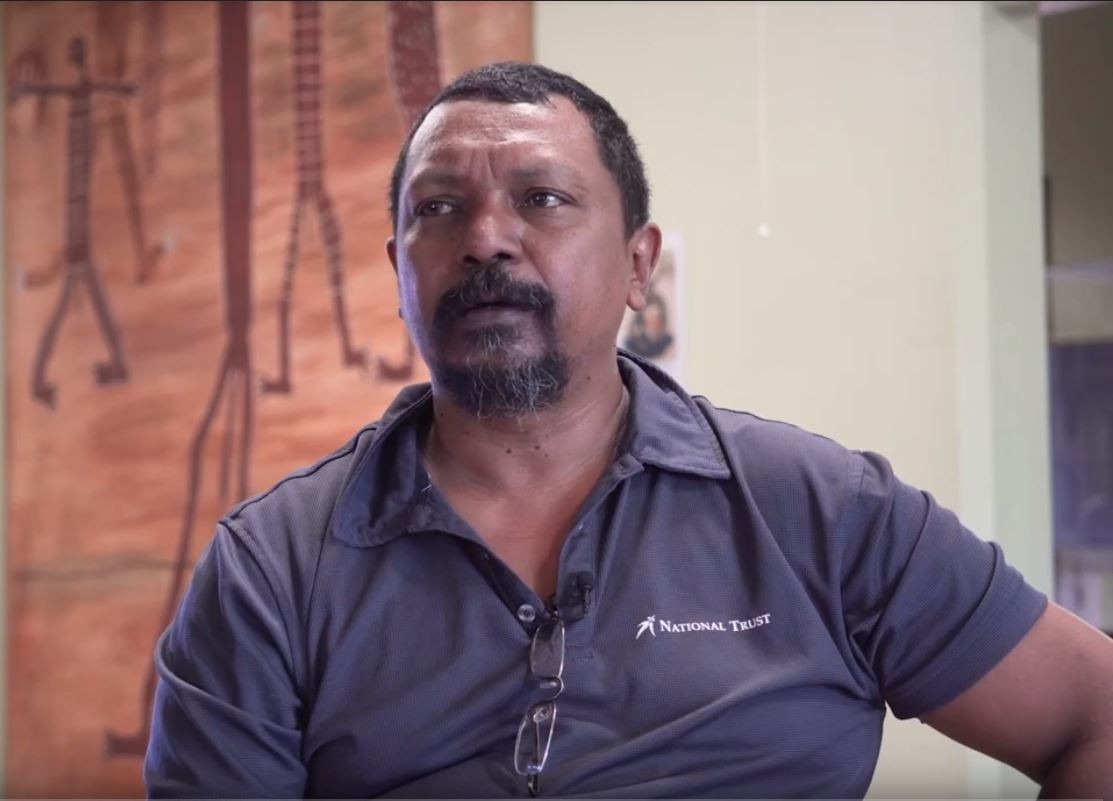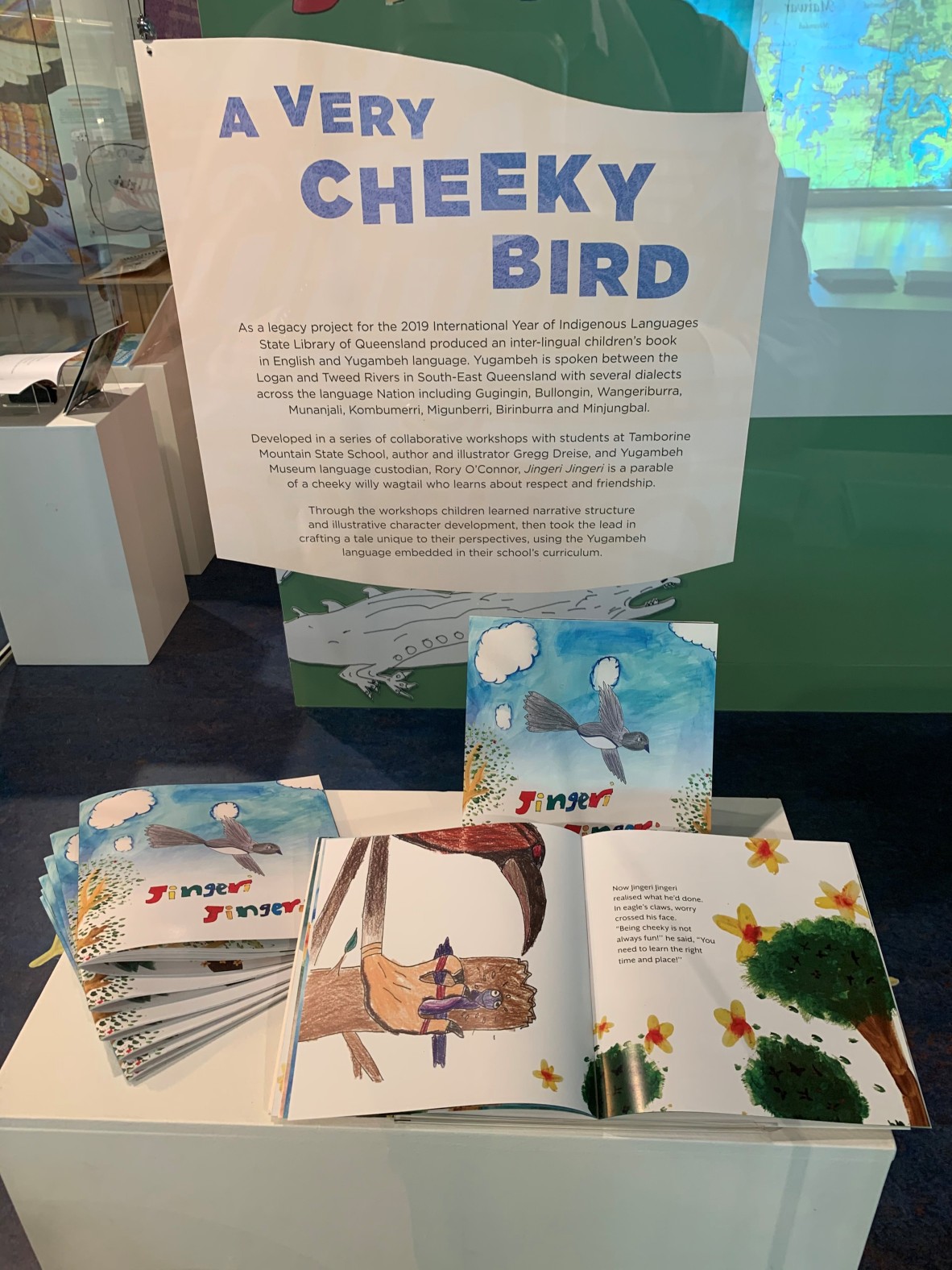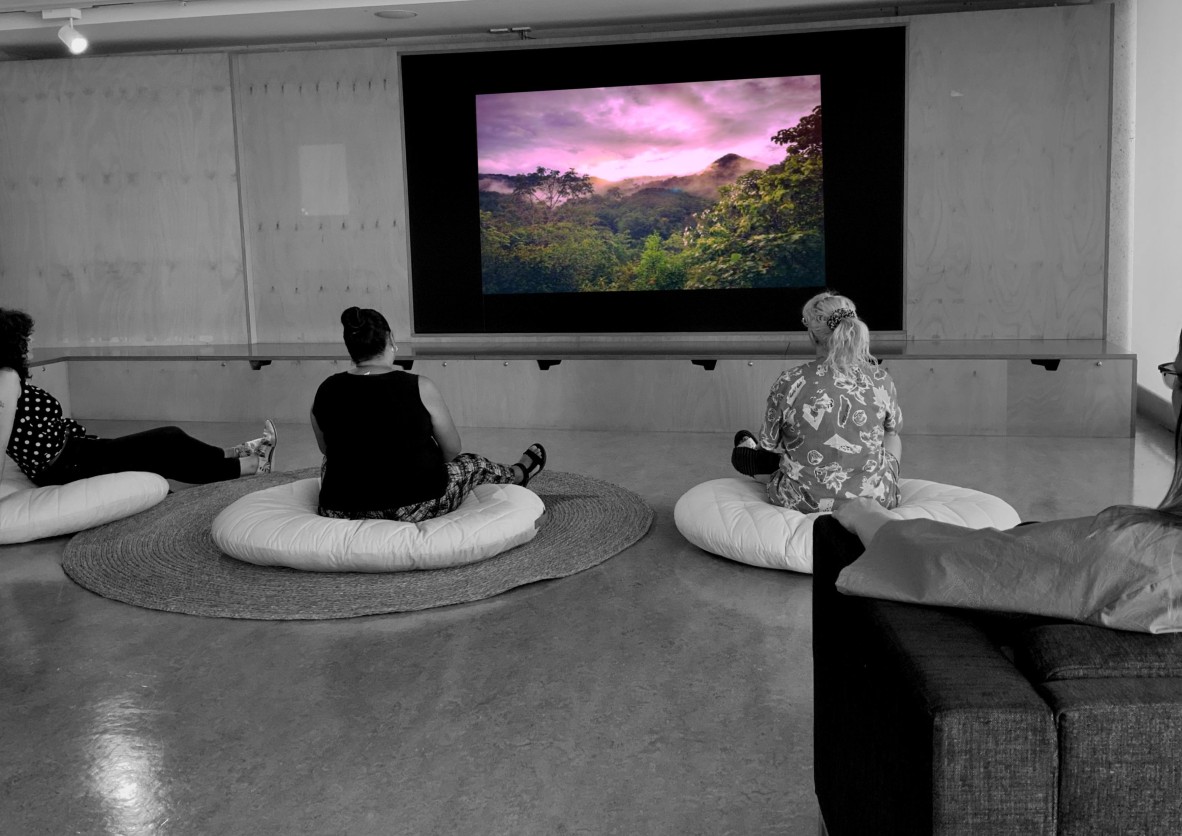
Old Words, New Ways.
Spoken and Jarjum Stories formed part of the State Library’s celebration of the International Year of Indigenous Languages – the exhibitions were interrupted by COVID-19; however, the interest from community prompted State Library to continue the language journey with Old Words, New Ways. Old Words, New Ways embraces elements from both exhibitions and presents it in a COVID-safe space.
The exhibition in kuril dhagun Showcase tells the story of Aboriginal and Torres Strait Islander languages and celebrates the strength and resilience of communities in reviving, maintaining and keeping their languages strong for future generations. Old Words, New Ways also highlights the work of State Library in supporting community languages – the Indigenous languages project has operated since 2007 and in that time has supported ~105 language communities across Queensland.

Harold Ludwick.
Lost in translation: this section looks at that first contact with Aboriginal and Torres Strait Islander people and their languages. In 1770, the Cook Journal represented the first written record of the Aboriginal languages of Australia. Alongside the Cook journal sits the Guugu Yimithirr story of those 41 days at Wahalumbaal Birri [pronounced wal-um-bail beery], the Endeavour River. Their oral history gives the shore-to-ship perspective – this is told by Harold Ludwick [above image]. You will hear about Gangurru [pronounced gun-gah-roo], the word the Guugu Yimithirr people gave the world - anglicized as “Kangaroo”!
Wik.thayanam.thawan [Strong in language].
Reawakening presents a selection of digital stories that highlight the resilience, passion and strength of communities to revive and maintain their languages; this is a ‘deep dive’ into 5 regions and their language communities:
- Yugambeh [pron. yoog-um-bear] – of Logan and the Gold Coast, the digital story tells the story of Yugambeh Museum and their language journey.
- Guugu Yimithirr [pron. goo-goo yim-a-thurr] – the digital story highlights the ongoing work of community members such as Lillian Bowen and Irene Hannant at the Hope Vale school, Dora Gibson and Shirley Costello at the Hope Vale IKC – it is a celebration of the strength of Guugu Yimithirr over the 250 years from when Cook wrote down those 130 words!
- Wik-Mungkan [pron. wick munk-an] – centred on Aurukun on Western Cape York – this is the strongest language on the Queensland Mainland. The Digital Story features Perry Yunkaporta and other community members using three languages to tell their story.
- Torres Strait Islander languages on the Mainland – this digital story highlights the work of Torres Strait Islanders living in Cairns and other mainland centres – 85% of Torres Strait Islanders live on the mainland, but how do you keep your language and culture strong far from home?
- Central West Queensland – the communities of Central West Queensland express and maintain their language through stories, art and even fashion design!

Jingeri Jingeri: a very cheeky bird.
Jingeri Jingeri was developed in a series of workshops with year 4 and 6 students of Mount Tamborine State School where they embed Yugambeh language into their curriculum. State Library also worked with Yugambeh language custodian Rory O’Connor and Gamilaroi author and illustrator Gregg Dreise. Gregg worked with the students to provide framework or formula for picture book storytelling and the kids directed the narrative from there and really took ownership of the work.
Our words, our stories: This section focuses on celebrating and elevating the voices of children and unique perspectives from Aboriginal and Torres Strait Islander communities in Queensland. It features the earliest published Aboriginal and Torres Strait Islander authors that paved the way for future storytellers.
- The Legends of Moonie Jarl: The first book to be published by an Aboriginal or Torres Strait Islander author in all of Australia was here in Queensland in 1964. The Legends of Moonie Jarl presents and illustrates traditional stories of the Butchulla people from K’Gari or Fraser Island. The publication is very unique in its use of story maps that employ a style of guided interpretation of the illustrations.
- The Rainbow Serpent: This book was first published in 1975 and is an iconic book for a whole generation of children who may have been learning about Aboriginal culture for the first time through the reading experience. For many Aboriginal children it was the first time they would have seen a book that reflects stories and culture similar to theirs.
- Stradbroke Dreamtime: This book was written by renowned poet and activist Oodgeroo Noonuccal. Oodgeroo authored this book as an extension of her activism in an effort to connect with the next generation of adults, to create awareness and change attitudes. In the showcase we have a signed first edition! In the collections, there are also various republished versions since the original 1972 publication.
- The original was highly edited which served to water down much of the activist intent. However, over time it has been restored to a version closer to the original manuscript.
- Stories from our Elders: This section explores contemporary storytellers who continue the tradition of weaving language, culture and moral lessons into accessible narratives for children and families to enjoy.
- Budburra Books: Budburra [pronounced bud-bah-ra], meaning echidna, began as a literacy project in Cherbourg and has provided an opportunity for children to retell traditional stories as well as new stories that reflect their experience of the world.
Many of the authors featured here retell traditional stories told to them, all of them use language words for elements of the story to introduce or reinforce its use in everyday life. This was a strong message from communities to ensure language and cultural knowledge was passed onto the younger generation.

Deep listening experience.
To complement the exhibition, there is a range of programming activities that encourages participants to explore Aboriginal and Torres Strait Islander languages.
- A deep listening experience is a soundscape featuring Yidaki and Taribelang language from the Bundaberg region
- Shared Stories is a program dedicated to helping you explore your own stories and how to retell them to others.
- Yarning Nets is a morning of fun and yarning through a series of weaving workshops facilitated by Nadine Foley from Culture Weave.
Further details on these events can be found at What's On!
State Library encourages you to continue the language journey and find out more about the Aboriginal and Torres Strait Islander languages of Queensland.
Desmond Crump
Indigenous Languages Coordinator, State Library of Queensland
State Library of Queensland Aboriginal and Torres Strait Islander Languages Webpages
State Library of Queensland Aboriginal and Torres Strait Islander Languages Map
Spoken: Celebrating Queensland languages exhibition
Jarjum Stories exhibition
Old Words, New Ways exhibition
Minya Birran: What next for Indigenous Languages?
Comments
Your email address will not be published.
We welcome relevant, respectful comments.